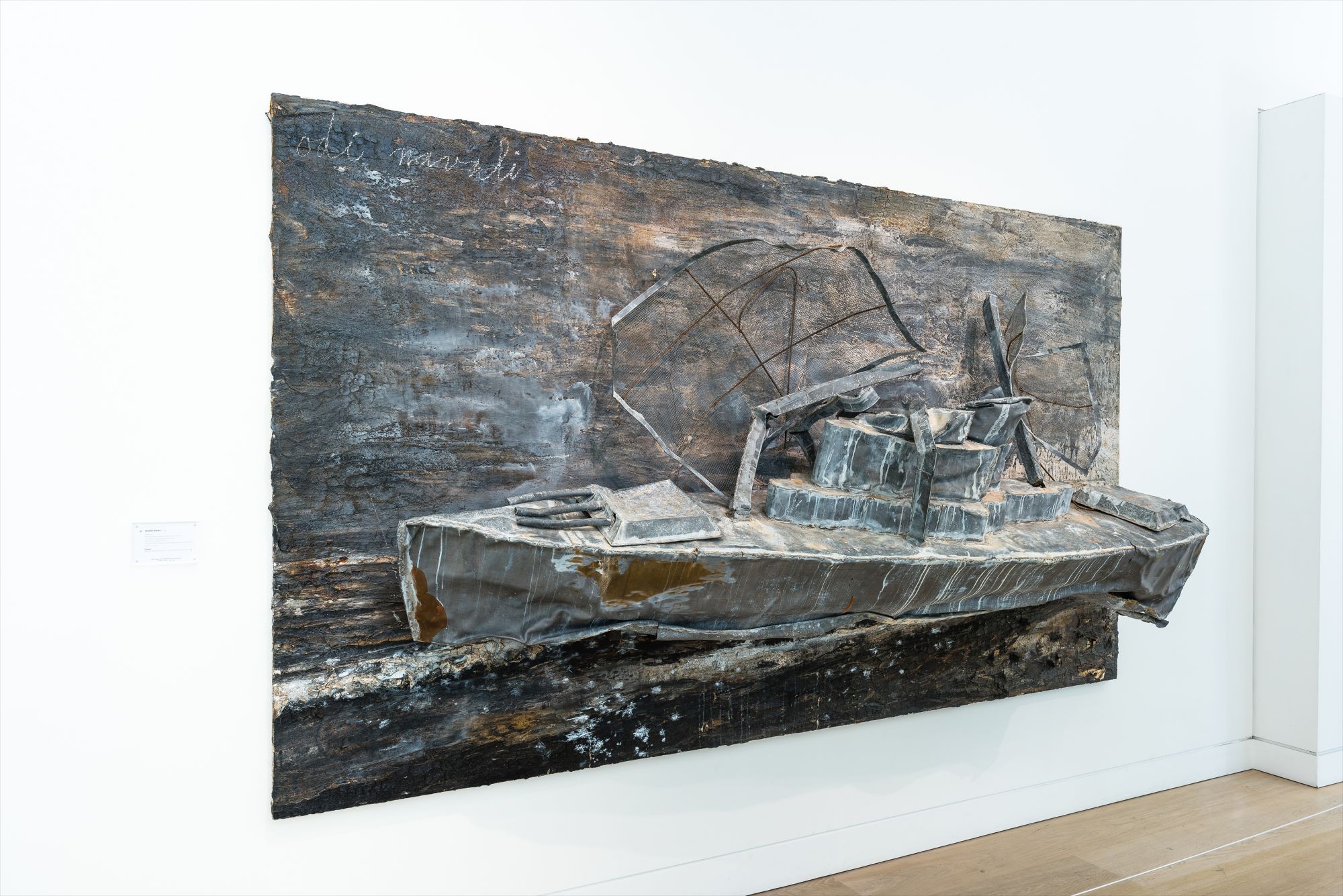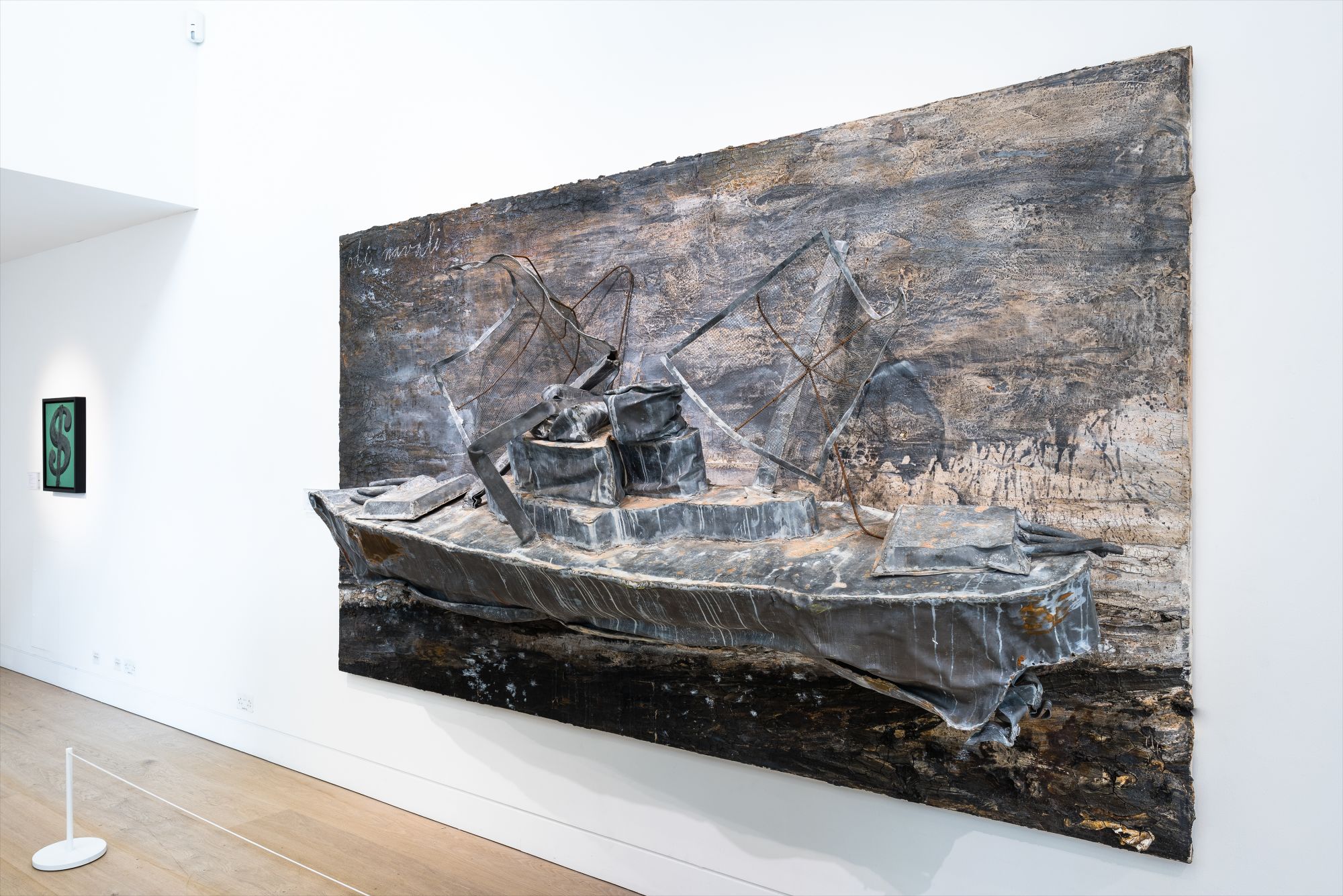







16
Anselm Kiefer
Odi Navali
titled "Odi Navali" upper left; dated 1997 on the reverse
oil, emulsion, acrylic and lead boat on canvas
189.9 x 330.2 cm (74 3/4 x 130 in.)
Executed in 1997, this work is accompanied by a certificate of authenticity signed by the artist.
Full-Cataloguing
Drifting on the muddied tides of history, the impossibly heavy lead ship of Anselm Kiefer's phenomenal painting-come-sculpture Odi Navali, buckles against its rigid supports as if collapsing under the grievous weight of war’s tragic annals. Weather-beaten and mangled it wallows amongst the swelling currents of impasto, crying lamenting tears of rust and emulsion that cascade from its battered hull into bubbling froth below. This work, realised on an enthralling scale, is a painting of astounding emotional affect and dramatic charge in which Kiefer exhibits the true extent of his artistic abilities and historical influences.
The title, Odi Navali, was taken from that of a series of poems by the Italian writer Gabriele D'Annunzio that describe, with great sadness, the death of Admiral Simone Pacoret di Saint-Bon - a renowned war hero and founder of the modern Italian Navy. The poet, D'Annunzio, was a notorious jingoist and aside from his influential writing, took a highly active role in Italy's WWI campaigns and even went so far as leading 2,000 militiamen to seize the city of Fiume in the inter-war years, hoping to annex it under Italian control. His irreverent proto-fascist rhetoric and thirst for political influence even saw some nationalists calling for his leadership in place of Mussolini's.
Along with the life and work of D'Annunzio, the title also engages with the conceptual underpinnings of a significant installation Kiefer produced in 2004 called Velimir Chlebnikov, which now resides on permanent seasonal display at the Hall Art Foundation, Vermont. This immersive work consists of a 1,000 square foot steel mausoleum containing thirty paintings dealing with nautical warfare, many of which contain ship motifs and the same inscription 'Odi Navali'. Among these comparable canvases, the present lot is by far the most impressive, both in ambition and execution. Yet this subtle connection links the work with the Russian Futurist Poet and experimental mathematician from the installations title, Velimir Chlebnikov, who devised a theory that prophesised the occurrence of major naval battles every 317 years. Though Kiefer dismisses the validity of Chlebnikov’s claims as nonsense, by adopting his thought processes Kiefer not only collapses conventional temporal structures by linking individual wars to the innumerable catastrophes that have recurred throughout all of human history, but he sees war through the warped perspectives of a man whose penchant for both creativity and the arcane could only be matched by the hermitic life of an artist. As Adrien Searle explains: '[Kiefer’s] interest in the utopian madness of Khlebnikov, whose example I believe he sees almost as a case study in self-mythology and the will to power, might be taken as a metaphor for artistic struggle. We cannot forget Hitler wanted to be an artist, too.' (Adrien Searle, "All at Sea," The Guardian, 5 July 2005, online resource).
Kiefer is indelibly drawn towards these defiant characters whose maniacal dogmas blind them from the conventions that are so apparent to many around them. He channels their ideas to form artistic anomalies that allow him, as a German artist, to adequately engage with twisted ideas and bitter motifs of the Second World War. But above all else, he emulates their irreverence, sequestering himself in his studio in the countryside of the French Provence, free to while away his time with the mystics of history in order to forge works of wild, uninhibited expression, implementing the demoniac tenets of war in order to best portray its grief.
The title, Odi Navali, was taken from that of a series of poems by the Italian writer Gabriele D'Annunzio that describe, with great sadness, the death of Admiral Simone Pacoret di Saint-Bon - a renowned war hero and founder of the modern Italian Navy. The poet, D'Annunzio, was a notorious jingoist and aside from his influential writing, took a highly active role in Italy's WWI campaigns and even went so far as leading 2,000 militiamen to seize the city of Fiume in the inter-war years, hoping to annex it under Italian control. His irreverent proto-fascist rhetoric and thirst for political influence even saw some nationalists calling for his leadership in place of Mussolini's.
Along with the life and work of D'Annunzio, the title also engages with the conceptual underpinnings of a significant installation Kiefer produced in 2004 called Velimir Chlebnikov, which now resides on permanent seasonal display at the Hall Art Foundation, Vermont. This immersive work consists of a 1,000 square foot steel mausoleum containing thirty paintings dealing with nautical warfare, many of which contain ship motifs and the same inscription 'Odi Navali'. Among these comparable canvases, the present lot is by far the most impressive, both in ambition and execution. Yet this subtle connection links the work with the Russian Futurist Poet and experimental mathematician from the installations title, Velimir Chlebnikov, who devised a theory that prophesised the occurrence of major naval battles every 317 years. Though Kiefer dismisses the validity of Chlebnikov’s claims as nonsense, by adopting his thought processes Kiefer not only collapses conventional temporal structures by linking individual wars to the innumerable catastrophes that have recurred throughout all of human history, but he sees war through the warped perspectives of a man whose penchant for both creativity and the arcane could only be matched by the hermitic life of an artist. As Adrien Searle explains: '[Kiefer’s] interest in the utopian madness of Khlebnikov, whose example I believe he sees almost as a case study in self-mythology and the will to power, might be taken as a metaphor for artistic struggle. We cannot forget Hitler wanted to be an artist, too.' (Adrien Searle, "All at Sea," The Guardian, 5 July 2005, online resource).
Kiefer is indelibly drawn towards these defiant characters whose maniacal dogmas blind them from the conventions that are so apparent to many around them. He channels their ideas to form artistic anomalies that allow him, as a German artist, to adequately engage with twisted ideas and bitter motifs of the Second World War. But above all else, he emulates their irreverence, sequestering himself in his studio in the countryside of the French Provence, free to while away his time with the mystics of history in order to forge works of wild, uninhibited expression, implementing the demoniac tenets of war in order to best portray its grief.